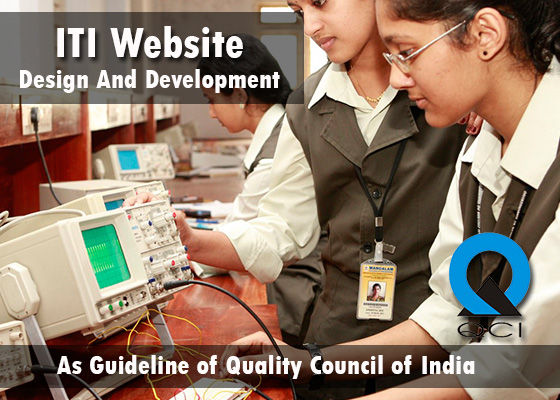Engineering Drawing Mechanical Group
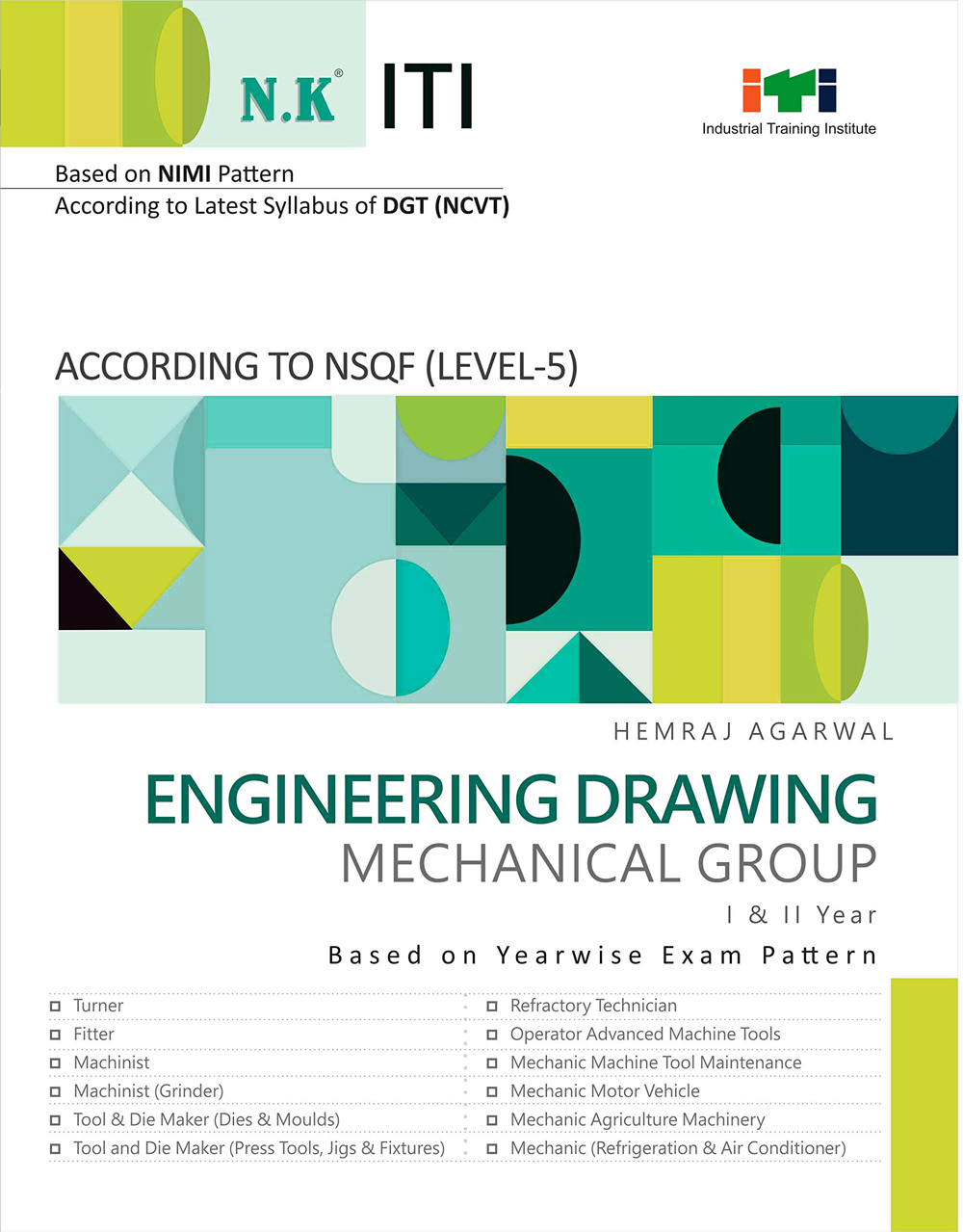
ITI Book Engineering Drawing Mechanical Group is by Hemraj Agarwal. Engineering Drawing Mechanical Group is according to Latest NSQF Level. Engineering Drawing Mechanical Group is according to latest syllabus of DGT(NCVT). Engineering Drawing Mechanical Group is for I Year, II Year. Engineering Drawing Mechanical Group is for ITI trade Fitter, Machinist, Machinist (Grinder), Tool & Die Maker (Dies & Moulds), Tool & Die Maker (Press Tools, Jigs & Fixtures), Turner . Engineering Drawing Mechanical Group have fundamental topic Introduction to Engineering Drawing, Lines and Lettering, Geometric Construction and Freehand Sketching of Plane Figure, Dimensioning, Size and Layout of Drawing Sheet, Projection, Symbolic Representation, Scale, Engineering Curves, Projection of Solids, Free Hand Sketch, Rivet and Riveted Joints, Screwed Fasteners, Detail and Assembly Drawing, Screw Threads, Mechanical Fasteners, Pipe Fittings, Gears and Pulleys, Sectioning, Blueprint Reading, Electro Technical Drawing and Symbols, Metal Estimation and Costing
Introduction to Engineering Drawing
- Engineering Drawing
- Importance of Engineering Drawing
- Relationship of Engineering Drawing with Artistic Drawing
- Relationship of Engineering Drawing with other Types of Drawings
- Conventions
- Viewing an Engineering Drawing Sheet
- Methods of Sheet Folding
- Drawing Instruments
Lines and Lettering
- Lines
- Types and Applications of Line as per BIS SP : 46-2003
- Classification of Lines
- Geometrical Aspects of Drawing Lines
- Procedure of Drawing Lines
- Lettering (BIS SP : 46-2003)
- Height and Width of Lettering
- General Rules for Lettering
- Styles of Lettering
Geometric Construction and Freehand Sketching of Plane Figure
- Angles
- Procedure of Drawing Angle
- Triangles
- Quadrilateral
- Circle
- Polygon
- Ellipse
- Freehand Sketching
Dimensioning
- Types of Dimensions
- Elements of Dimensioning
- Method of Dimensioning of Some Common Features
- Rules of Dimensioning
- Arrowhead
Size and Layout of Drawing Sheet
- Basic Principle of Sheet Size
- Selection of Sheet Size
- Layout on Drawing Sheets
- Item Reference on Drawing and Item List
- Revision Table
Projection
- Principle of Projection
- Projection Methods
- Plane of Projection
- Types of Projection
- Conversion of Isometric Views into Orthographic Views
Symbolic Representation
- Symbolic Representation of Fastener
- Symbolic Representation of Bar and Profile Section
- Symbolic Representation of Weld, Brazed Soldered Joints
- Symbolic Representation of Pipe Fitting and Valve Symbols
- Symbolic Representation of Pipe Fitting Joints
- Symbolic Representation of Electrical and Electronic Elements
- General Symbols of Electric Components
Scale
- Representative Fraction
- Different Types of Scales
Engineering Curves
- Conic Section
- Ellipse
- Parabola
- Hyperbola
Projection of Solids
- Classification of Solids
- Positions of the Solids
- Solids with Axis Perpendicular to an RP
- Rules for Deciding the Hidden Lines
Free Hand Sketch
- Measuring and Checking Tools
- Marking Tools
- Striking Tools
- Cutting Tools
- Holding Device
- Assembling Tools
- Mechanic Diesel
- Welding
Engineering Drawing Mechanical
- Holding Devices
- Duct Systems
Rivet and Riveted Joints
- Fastener
- Classificaion of Fastener
- Rivets
- Riveting
- Types of Rivets
- Forms and Proportions of Rivet Heads
- Caulking and Fullering
- Terms and Empirical Proportions of Riveted Joints
- Riveted Joints
- Solved Problems
Screwed Fasteners
- Bolts
- Nut
- Hexagonal Nut and Bolt
- Square Bolt and Washer
- Washer
- Screw
- Locking Arrangements of Nuts
- Foundation Bolts
- Conventional Symbols for Nut and Bolts
Detail and Assembly Drawing
- Detail or Part Drawing
- Assembly Drawing
- Symbols Used to Indicate Surface Roughness
- Roughness Symbols
- Indication of Machining Allowance
- Position of the Specification of Surface Roughness in the Symbol
- Indications of Surface Roughness Symbols on Drawings
- Fits
- Types of Fits
- Expression of a Fit
- Geometrical Tolerance
- Making Assembly Drawing from Details
- Making Detail Drawing from Assembly
- Assembly Drawing of Different Parts
Screw Threads
- Elements of Screw Thread
- Terminology Used
- Classification of Screw Threads
- Applications of Screw Threads
Mechanical Fasteners
- Key
- Taper Pin or Key
- Bolt
- Nut
- Washer
- Screws
- Locking Arrangement of Nuts
Engineering Drawing Mechanical
- Key
- Circlips
- Set Collars
- Taper Pins
- Cotter
- Use of Pins in Connecting Shafts
- Flange Coupling
- Muff Coupling
- Bearings
Pipe Fittings
- Pipe Threads
- Pipe Fitting and Valve Symbols
Gears and Pulleys
- Gear Teeth
- Types of Gears
- Elements of Gears
- Pulleys
- Chamfer
- Fillet
Sectioning
- Types of Sectioning
- Cross Sectional View of Various Objects
- Hatching Techniques
- Sectioning of Complex Objects
- Precautions
- Sectioning Lines for Different Materials
- Orthographic Projection of Sectioned Objects
Blueprint Reading
- Identification of Blueprint Symbols
Electro Technical Drawing and Symbols
- General Symbols
- Graphical Symbols Used for Electrical Installation in a Building
- Electric Wiring Related Symbols According to BIS
- Electrical Circuits and Variabilities Symbols
- Symbols of Variable Resistors
- Identification of Electrical Instruments
- BIS Symbols Related to DC and AC Machine Circuit
- Lettering Codes for Terminal Marking Concerning DC Machines
- BIS Symbols-Switchgear and Accessories
Metal Estimation and Costing
- Metal Estimation
- Costing
ITI Book Engineering Drawing Mechanical Group is by Hemraj Agarwal. Engineering Drawing Mechanical Group is according to Latest NSQF Level. Engineering Drawing Mechanical Group is according to latest syllabus of DGT(NCVT). Engineering Drawing Mechanical Group is for I Year, II Year. Engineering Drawing Mechanical Group is for ITI trade Fitter, Machinist, Machinist (Grinder), Tool & Die Maker (Dies & Moulds), Tool & Die Maker (Press Tools, Jigs & Fixtures), Turner . Engineering Drawing Mechanical Group have fundamental topic Introduction to Engineering Drawing, Lines and Lettering, Geometric Construction and Freehand Sketching of Plane Figure, Dimensioning, Size and Layout of Drawing Sheet, Projection, Symbolic Representation, Scale, Engineering Curves, Projection of Solids, Free Hand Sketch, Rivet and Riveted Joints, Screwed Fasteners, Detail and Assembly Drawing, Screw Threads, Mechanical Fasteners, Pipe Fittings, Gears and Pulleys, Sectioning, Blueprint Reading, Electro Technical Drawing and Symbols, Metal Estimation and Costing
Fitter
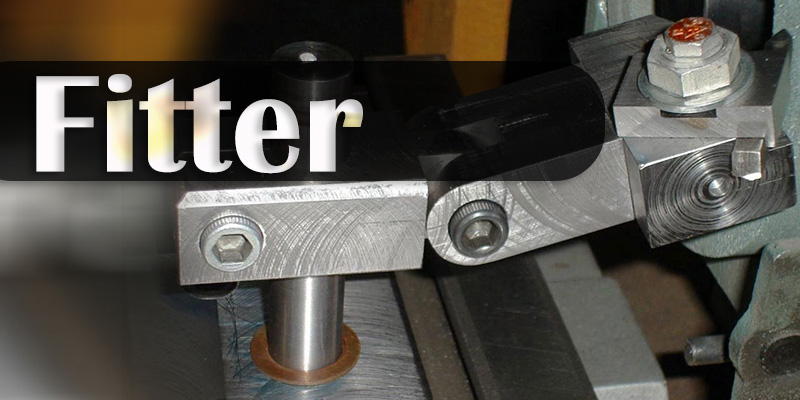
ITI trade Fitter is powered by NCVT. ITI trade Fitter is a job oriented trade ITI trade Fitter is suitable for government job and private job. This ITI trade Fitter is very powerful for self-empowerment. This ITI trade Fitter is perfectly design to fulfill industrial requirement of Indian Industries as well as International industries.
Fitters have a wide scope of Employability ranging from self-employment, contractual employment to Industrial jobs. On successful completion of this course, the candidates shall be gainfully employed in the following industries:
- Production & Manufacturing industries.
- Structural Fabrication like bridges, Roof structures, Building & construction.
- Automobile and allied industries
- Service industries like road transportation and Railways.
- Ship building and repair
- Infrastructure and defence organizations
- In public sector industries like BHEL, BEML, NTPC, etc and private industries in India & abroad.
- Self employment
International Comparability
- Existence of any official document suggesting the comparability of the qualification with the qualifications in other countries is not known.
- However, ITI passed out trainees are getting employment in many Gulf countries, European countries, Australia, New Zealand, Singapore etc.
Progression Pathway
- Can appear in 10+2 examination through National Institute of Open Schooling (NIOS) for acquiring higher secondary certificate and can go further for General/ Technical education
- Can take admission in diploma course in notified branches of Engineering by lateral entry
- Can join as semi-skilled worker in the industry and can become supervisor after doing part-time diploma in relevant branch of Engineering
- Can join Apprenticeship programme in different types of industries leading to National Apprenticeship certificate (NAC) after which they will be employed in industry as skilled worker and can become supervisor after doing part-time diploma in relevant branch of Engineering
- Can join Crafts Instructor Training Scheme (CITS) in the relevant trade after which they will be employed in ITI/ Vocational Training Institute as instructor
Machinist
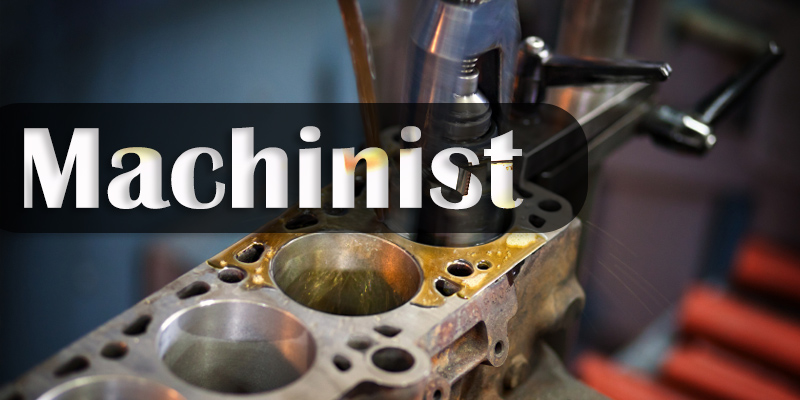
ITI trade Machinist is powered by NCVT. ITI trade Machinist is a job oriented trade ITI trade Machinist is suitable for government job and private job. This ITI trade Machinist is very powerful for self-empowerment. This ITI trade Machinist is perfectly design to fulfill industrial requirement of Indian Industries as well as International industries.
On successful completion of this course, the candidates shall be gainfully employed as:
• Machinist, Grinder, Operator of various types of power driven metal cutting or grinding machines in Production & Manufacturing industries,Infrastructure and defence organizations.
• Machinists have a wide scope of Employability ranging from self-employment, contractual employment to Industrial jobs.
International Comparability
- 1. Comparison Made with German Syllabus and the proposed syllabus is in line with the existing German Syllabus (Around 95% contents are matching).
- 2. However, ITI passed out trainees are getting employment in many Gulf countries, European countries, Australia, New Zealand, Singapore etc.
Progression Pathway
- Can appear in 10+2 examination through National Institute of Open Schooling (NIOS) for acquiring higher secondary certificate and can go further for General/ Technical education
- Can take admission in diploma course in notified branches of Engineering by lateral entry
- Can become supervisor after doing part-time diploma in relevant branch of Engineering.
- Can join Apprenticeship programme in different types of industries leading to National Apprenticeship certificate (NAC) after which they will be employed in industry as skilled worker and can become supervisor after doing part-time diploma in relevant branch of Engineering
- Can join Crafts Instructor Training Scheme (CITS) in the relevant trade after which they will be employed in ITI/ Vocational Training Institute as instructor
Machinist (Grinder)
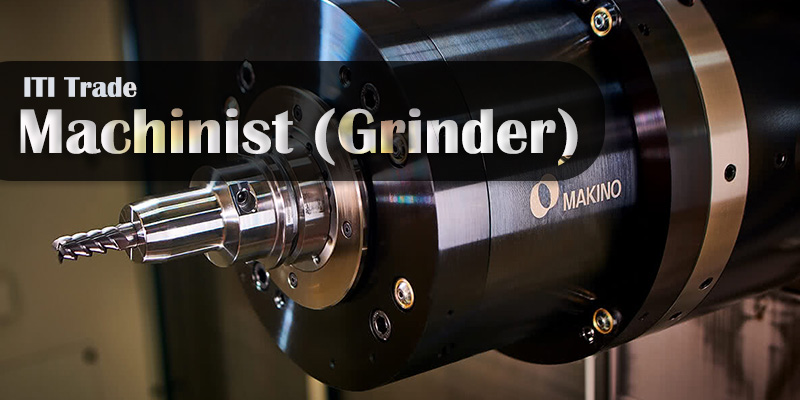
ITI trade Machinist (Grinder) is powered by NCVT. ITI trade Machinist (Grinder) is a job oriented trade ITI trade Machinist (Grinder) is suitable for government job and private job. This ITI trade Machinist (Grinder) is very powerful for self-empowerment. This ITI trade Machinist (Grinder) is perfectly design to fulfill industrial requirement of Indian Industries as well as International industries.
Machinist Grinder has a wide scope of Employability ranging from self-employment, contractual employment to Industrial jobs. On successful completion of this course, the candidates shall be gainfully employed in the industries for following occupations:
• Grinder, General
• Surface Grinder
• Roll Grinder
• Honer/Honing Machine Operator
• Lapper
• Grinder, Tool and Cutter
• In public sector and private industries in India & abroad.
• Self employment
International Comparability
1. Existence of any official document suggesting the comparability of the qualification with the qualifications in other countries is not known.
2. However, ITI passed out trainees are getting employment in many Gulf countries, European countries, Australia, New Zealand, Singapore etc.
Progression Pathway
- Can appear in 10+2 examination through National Institute of Open Schooling (NIOS) for acquiring higher secondary certificate and can go further for General/ Technical education.
- Can take admission in diploma course in notified branches of Engineering by lateral entry.
- Can join Apprenticeship programme in different types of industries leading to National Apprenticeship certificate (NAC).
- Can join Crafts Instructor Training Scheme (CITS) in the relevant trade after
Tool & Die Maker (Dies & Moulds)
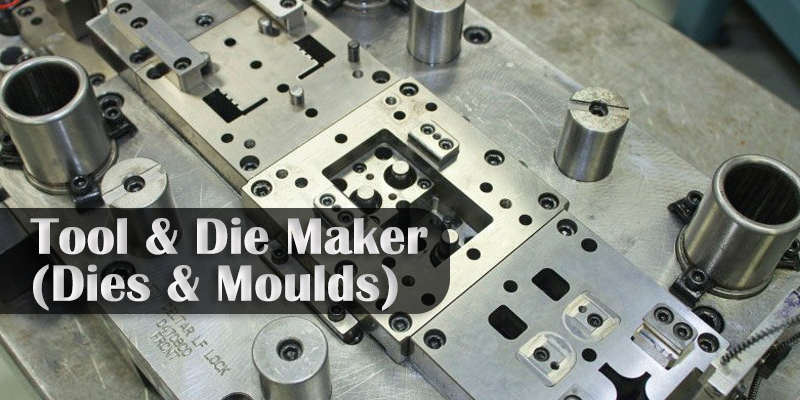
1. Introduction:
This course is meant for the candidates who aspire to become a professional Tool and Die maker (Dies & Moulds).
.
2. Terminal Competency/Deliverables:
After successful completion of this course the trainee shall be able to perform the following skills with proper sequence.
- 1. The trainees can work in the industry as semi-skilled Tool and Die Maker (Dies & Moulds).
- 2. The trainee can able to manufacture different components for dies & moulds by operating different machines like lathe, drilling, welding, milling grinding, EDM, Injection moulding and CNC. Inspection & measurement of different components and observing safety precautions while working.
- 3. The trainees can work on Dismantle & assemble of various dies & moulds and test.
- 4. Trainee is able to make simple programme on CNC machine and operate.
- 5. Handle different type of Fire extinguishers.
3.. Employment opportunities:
On successful completion of this course, the candidates shall be gainfully employed in
the following industries:
- 1. Production & Manufacturing industries.
- 2. Structural Fabrication like bridges, Roof structures, Building & construction.
- 3. Automobile and allied industries
- 4. Service industries like road transportation and Railways.
- 5. Ship building and repair
- 6. Infrastructure and defense organizations
- 7. In public sector industries like BHEL, BEML, NTPC, etc and private industries in India & abroad.
- 8. Self employment
Tool & Die Maker (Press Tools, Jigs & Fixtures)
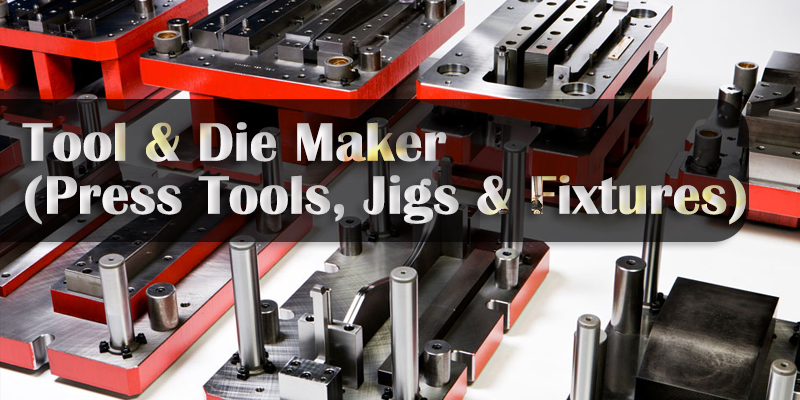
ITI trade Tool & Die Maker (Press Tools, Jigs & Fixtures) is powered by NCVT. ITI trade Tool & Die Maker (Press Tools, Jigs & Fixtures) is a job oriented trade ITI trade Tool & Die Maker (Press Tools, Jigs & Fixtures) is suitable for government job and private job. This ITI trade Tool & Die Maker (Press Tools, Jigs & Fixtures) is very powerful for self-empowerment. This ITI trade Tool & Die Maker (Press Tools, Jigs & Fixtures) is perfectly design to fulfill industrial requirement of Indian Industries as well as International industries.
During the two years duration, a candidate is trained on subjects- Professional Skill, Professional Knowledge, Engineering Drawing, Workshop Science & Calculation and Employability Skills. In addition to this, a candidate is entrusted to make/do project work and Extra Curricular Activities to build up confidence. The practical skills are imparted in simple to complex manner & simultaneously theory subject is taught in the same fashion to apply cognitive knowledge while executing task.
The course covers the detail aspect of mould making& testing. The broad components covered under Professional Skill subject are as below:
1st Semester– The practical part starts with basic fitting covering components like filing, sawing, drilling, tapping, chipping, grinding and different fits. The accuracy proposed is of ±0.05mm and angular accuracy of 1. Different turning operations on lathe viz., plain, facing, boring, grooving, step turning, parting, chamfering, knurling and different thread cutting by setting the different parameter, are covered in the practical part.
2ndSemester– Different milling operations (plain, stepped, angular, dovetail, T-slot, contour, gear) along with surface & cylindrical grinding to an accuracy of ±0.02mm are covered. In addition, solid modeling of mould in CAD & Pro E taught setting and execution of welding is also a component in this semester.
3rdSemester– Setting, operation and programming of CNC turn centre and CNC machining centre to produce components are performed in this semester. 2D & 3D machining with CAM software is also performed. Manufacture drill jig and fixture is also part of the practical. EDM & wire EDM operation to produce components with an accuracy of ±0.02mm is covered. Construction of blanking and piercing tool is done and testing of same is also performed.
4th Semester– Basic construction of Hydraulic & Pneumatic circuits and basic functioning of electrical circuit and sensors are covered in this semester. Construction of compound and progressive tools is done testing of same is executed. Simple repair and overhauling of different machines viz., drill, milling & lathe is covered. Making of ‘V’ bending tool and draw tool are carried out and testing is also undertaken.
Turner
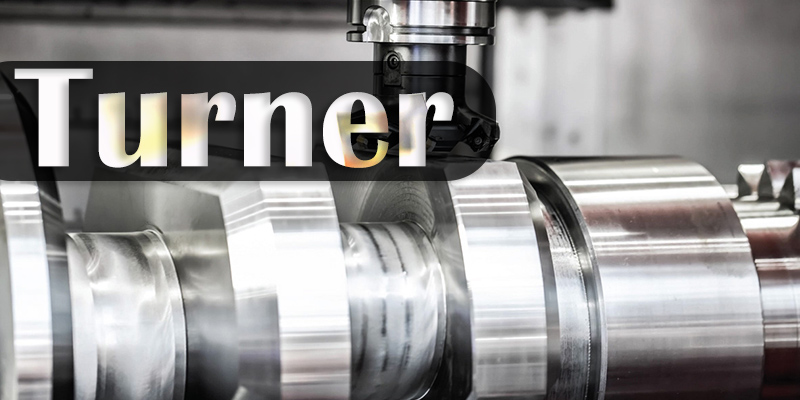
ITI trade Turner is powered by NCVT. ITI trade Turner is a job oriented trade ITI trade Turner is suitable for government job and private job. This ITI trade Turner is very powerful for self-empowerment. This ITI trade Turner is perfectly design to fulfill industrial requirement of Indian Industries as well as International industries.
After successful completion the passed out trainee
- 1. Can work in the industry as skilled turner.
- 2. Can work in the field of basic fitting, lathe, drilling, Inspection & measurement observing safety precautions.
- 3. Can perform all the turning operations on lathe & perform simple programming & operations on a CNC lathe.
- 4. Can handle different type of Fire extinguishers & personal protective equipment.
Neelkanth Publishers

Welcome to Neelkanth Publishers or NK as it is popularly known. In the last ten years, we have published more than 1100 titles and editions of text books, solved question papers in different segments including Engineering, ITI,Polytechnic and Skill Development. We believe in making quality books which are easy to understand, have lucid language and have simple and attractive illustrations. Our authors include some of the most well-known names in their respective fields. Though are books are prepared after painstaking and extensive research with numerous revisions for language and content, yet they are affordable for the masses and hence are popular in the entire country.
https://neelkanthpublishers.com/
ITI text and hand books
Introduction to Engineering Drawing
Engineering Drawing
Importance of Engineering Drawing
Relationship of Engineering Drawing with Artistic Drawing
Relationship of Engineering Drawing with other Types of Drawings
Conventions
Viewing an Engineering Drawing Sheet
Methods of Sheet Folding
Drawing Instruments
Lines and Lettering
Lines
Types and Applications of Line as per BIS SP : 46-2003
Classification of Lines
Geometrical Aspects of Drawing Lines
Procedure of Drawing Lines
Lettering (BIS SP : 46-2003)
Height and Width of Lettering
General Rules for Lettering
Styles of Lettering
Geometric Construction and Freehand Sketching of Plane Figure
Angles
Procedure of Drawing Angle
Triangles
Quadrilateral
Circle
Polygon
Ellipse
Freehand Sketching
Dimensioning
Types of Dimensions
Elements of Dimensioning
Method of Dimensioning of Some Common Features
Rules of Dimensioning
Arrowhead
Size and Layout of Drawing Sheet
Basic Principle of Sheet Size
Selection of Sheet Size
Layout on Drawing Sheets
Item Reference on Drawing and Item List
Revision Table
Projection
Principle of Projection
Projection Methods
Plane of Projection
Types of Projection
Conversion of Isometric Views into Orthographic Views
Symbolic Representation
Symbolic Representation of Fastener
Symbolic Representation of Bar and Profile Section
Symbolic Representation of Weld, Brazed Soldered Joints
Symbolic Representation of Pipe Fitting and Valve Symbols
Symbolic Representation of Pipe Fitting Joints
Symbolic Representation of Electrical and Electronic Elements
General Symbols of Electric Components
Scale
Representative Fraction
Different Types of Scales
Engineering Curves
Conic Section
Ellipse
Parabola
Hyperbola
Projection of Solids
Classification of Solids
Positions of the Solids
Solids with Axis Perpendicular to an RP
Rules for Deciding the Hidden Lines
Free Hand Sketch
Measuring and Checking Tools
Marking Tools
Striking Tools
Cutting Tools
Holding Device
Assembling Tools
Mechanic Diesel
Welding
Rivet and Riveted Joints
Fastener
Classificaion of Fastener
Rivets
Riveting
Types of Rivets
Forms and Proportions of Rivet Heads
Caulking and Fullering
Terms and Empirical Proportions of Riveted Joints
Riveted Joints
Solved Problems
Screwed Fasteners
Bolts
Nut
Hexagonal Nut and Bolt
Square Bolt and Washer
Washer
Screw
Locking Arrangements of Nuts
Foundation Bolts
Conventional Symbols for Nut and Bolts
Detail and Assembly Drawing
Detail or Part Drawing
Assembly Drawing
Symbols Used to Indicate Surface Roughness
Roughness Symbols
Indication of Machining Allowance
Position of the Specification of Surface Roughness in the Symbol
Indications of Surface Roughness Symbols on Drawings
Fits
Types of Fits
Expression of a Fit
Geometrical Tolerance
Making Assembly Drawing from Details
Making Detail Drawing from Assembly
Assembly Drawing of Different Parts
Screw Threads
Terminology Used
Classification of Screw Threads
Applications of Screw Threads
Mechanical Fasteners
Key
Circlips
Set Collars
Taper Pins
Cotter
Use of Pins in Connecting Shafts
Flange Coupling
Muff Coupling
Bearings
Pipe Fittings
Pipe Threads
Pipe Fitting and Valve Symbols
Gears and Pulleys
Gear Teeth
Types of Gears
Elements of Gears
Pulleys
Chamfer
Fillet
Sectioning
Types of Sectioning
Cross Sectional View of Various Objects
Hatching Techniques
Sectioning of Complex Objects
Precautions
Sectioning Lines for Different Materials
Orthographic Projection of Sectioned Objects
Blueprint Reading
Identification of Blueprint Symbols
Electro Technical Drawing and Symbols
General Symbols
Graphical Symbols Used for Electrical Installation in a Building
Electric Wiring Related Symbols According to BIS
Electrical Circuits and Variabilities Symbols
Symbols of Variable Resistors
Identification of Electrical Instruments
BIS Symbols Related to DC and AC Machine Circuit
Lettering Codes for Terminal Marking Concerning DC Machines
BIS Symbols-Switchgear and Accessories
Free Hand Sketch
Holding Devices
Duct Systems
Metal Estimation and Costing
Metal Estimation
Costing
ITI Student Resume Portal
रिज्यूम पोर्टल का मुख्य उद्देश्य योग्य छात्रों की जानकारी सार्वजनिक पटल पर लाने की है जिससे जिन्हें आवश्यकता हो वह अपने सुविधा अनुसार छात्रों का चयन कर सकते हैं
ITI Student Resume
Search engine adsence
अडाना | अभोगी कान्ह्डा | अल्हैया बिलावल | अल्हैयाबिलावल | अहीर भैरव | अहीरभैरव | आनंदभैरव | आसावरो | ककुभ | कलावती | काफ़ी | काफी | कामोद | कालिंगड़ा जोगिया | कीरवाणी | केदार | कोमल-रिषभ आसावरी | कौशिक कान्हड़ा | कौशिक ध्वनी (भिन्न-षड्ज) | कौसी | कान्ह्डा | खंबावती | खमाज | खम्बावती | गारा | गुणकली | गुर्जरी तोडी | गोपिका बसन्त | गोरख कल्याण | गौड मल्हार | गौड सारंग | गौड़मल्लार | गौड़सारंग | गौरी | गौरी (भैरव अंग) |चन्द्रकान्त | चन्द्रकौन्स | चारुकेशी | छाया-नट | छायानट | जयजयवन्ती | जयतकल्याण | जलधर | केदार | जेजैवंती | जेतश्री | जैत | जैनपुरी | जोग | जोगकौंस | जोगिया | जोगेश्वरी | जौनपुरी | झिंझोटी | टंकी | तिलंग | तिलंग बहार | तिलककामोद | तोडी | त्रिवेणी | दरबारी कान्हड़ा | दरबारी कान्हडा | दीपक | दुर्गा | दुर्गा द्वितीय | देव गन्धार | देवगंधार | देवगिरि बिलावल | देवगिरी | देवर्गाधार | देवश्री | देवसाख | देश | देशकार | देस | देसी | धनाश्री | धानी | नंद | नट भैरव | नट राग | नटबिलावल | नायकी कान्ह्डा | नायकी द्वितीय | नायकीकान्हड़ा | नारायणी | पंचम | पंचम जोगेश्वरी | पटदीप | पटदीपकी | पटमंजरी | परज | परमेश्वरी | पहाड़ी | पीलू | पूरिया | पूरिया कल्याण | पूरिया धनाश्री | पूर्याधनाश्री | पूर्वी | प्रभात | बंगालभैरव | बड़हंससारंग | बसन्त | बसन्त मुखारी | बहार | बागेश्री | बागेश्वरी | बिलावल शुद्ध | बिलासखानी तोडी | बिहाग | बैरागी | बैरागी तोडी | भंखार | भटियार | भीम | भीमपलासी | भूपाल तोडी | भूपाली | भैरव | भैरवी | मधमाद सारंग | मधुकौंस | मधुवन्ती | मध्यमादि सारंग | मलुहा | मल्हार | मांड | मारवा | मारू बिहाग | मालकौंस | मालकौन्स | मालगुंजी | मालश्री | मालीगौरा | मियाँ की मल्लार | मियाँ की सारंग | मुलतानी | मेघ | मेघ मल्हार | मेघरंजनी | मोहनकौन्स | यमन | यमनी | रागेश्री | रागेश्वरी | रामकली | रामदासी मल्हार | लंका-दहन सारंग | लच्छासाख |ललिट | ललित | वराटी | वसंत | वाचस्पती | विभाग | विभास | विलासखानी तोड़ी | विहाग | वृन्दावनी सारंग | शंकरा | शहाना | शहाना कान्ह्डा | शिवभैरव | शिवरंजनी | शुक्लबिलावल | शुद्ध कल्याण | शुद्ध मल्लार | शुद्ध सारंग | शोभावरी | श्याम | श्याम कल्याण | श्री | श्रीराग | षट्राग | सरपर्दा | सरस्वती | सरस्वती केदार | साजगिरी | सामंतसारंग | सारंग (बृंदावनी सारंग) | सिंदूरा | सिंधुभैरवी | सिन्धुरा | सुघराई | सुन्दरकली | सुन्दरकौन्स | सूरदासी मल्हार | सूरमल्लार | सूहा | सैंधवी | सोरठ | सोहनी | सौराष्ट्रटंक | हंसकंकणी | हंसकिंकिणी | हंसध्वनी | हमीर | हरिकौन्स | हामीर | हिंदोल | हिन्डोल | हेमंत |हेमकल्याण | हेमश्री |

